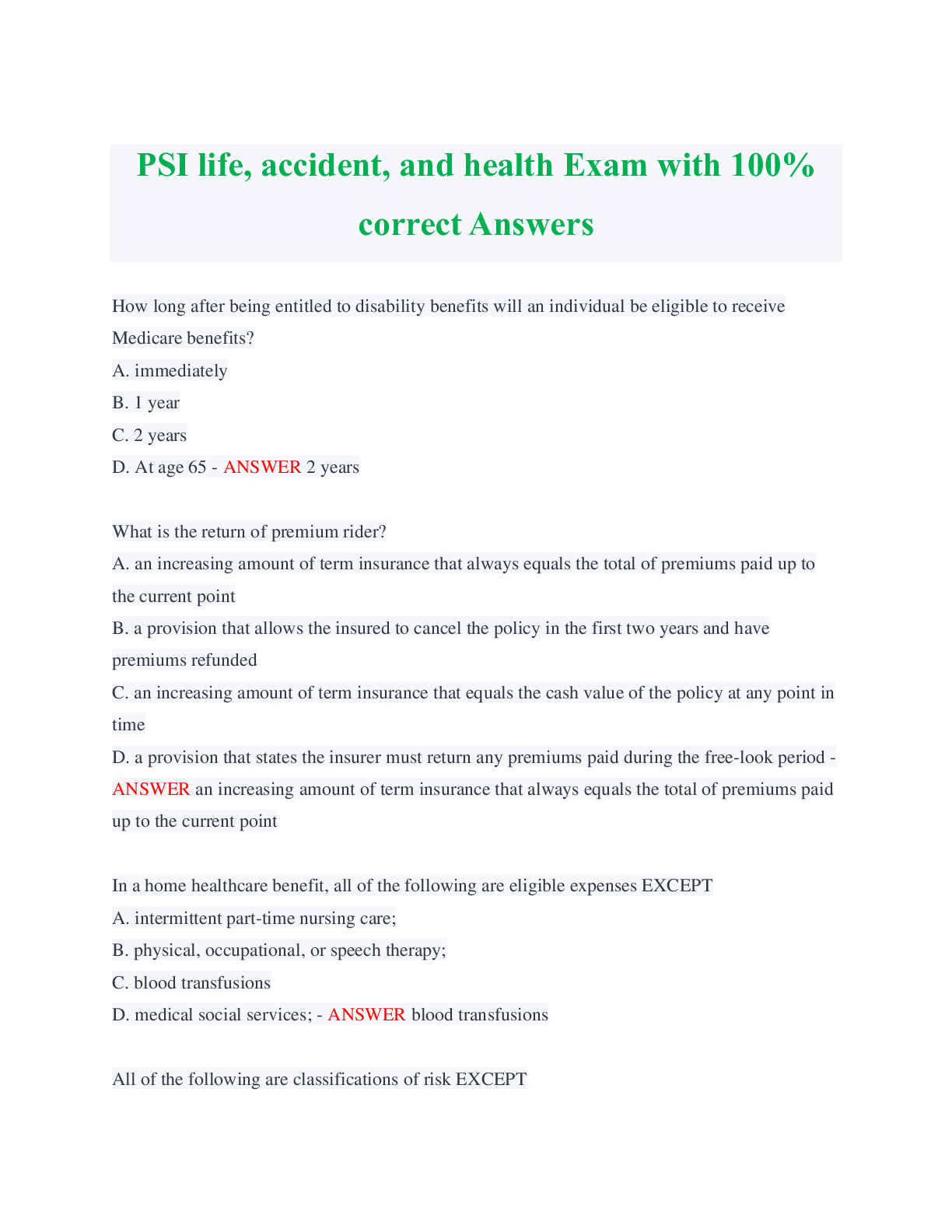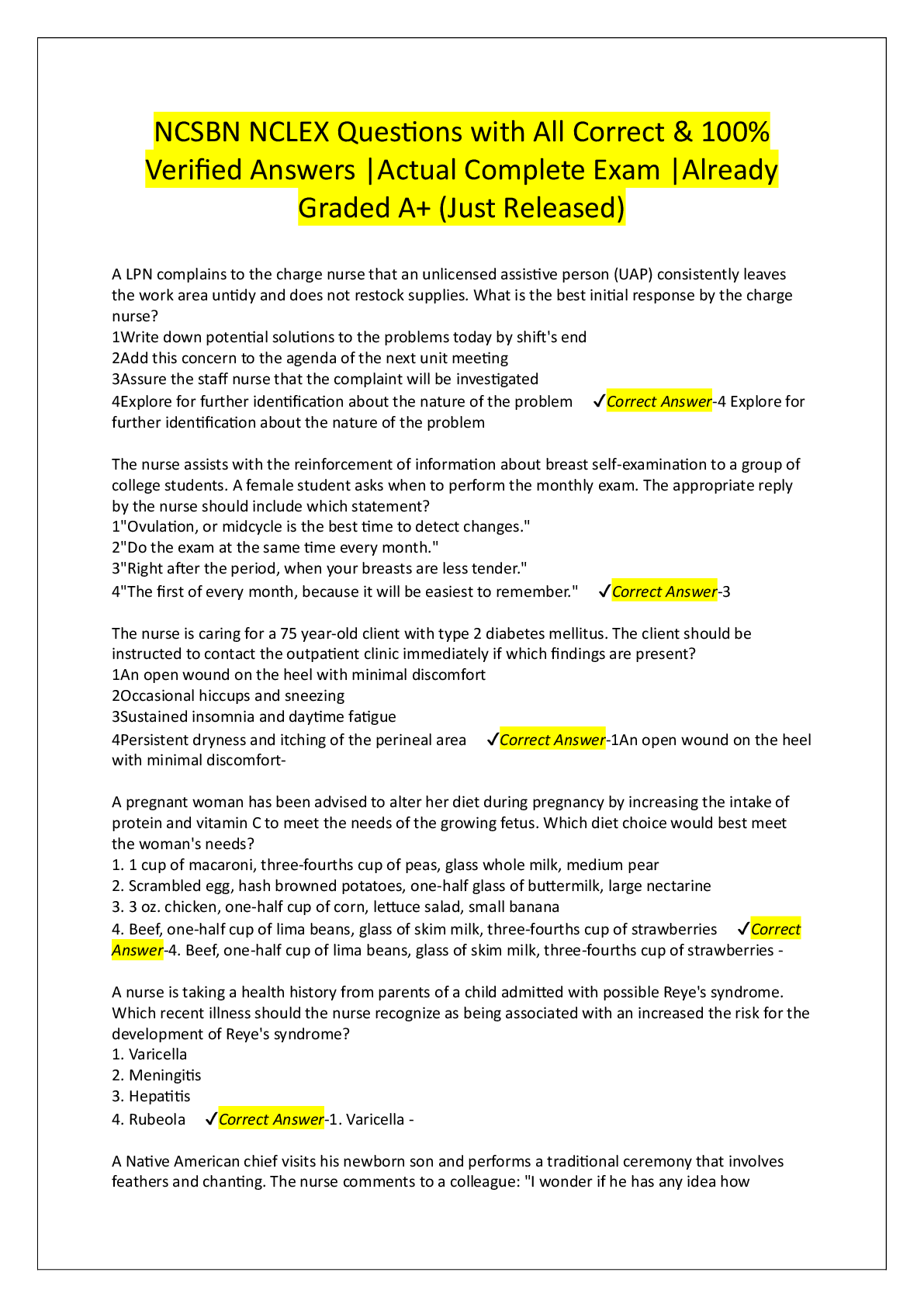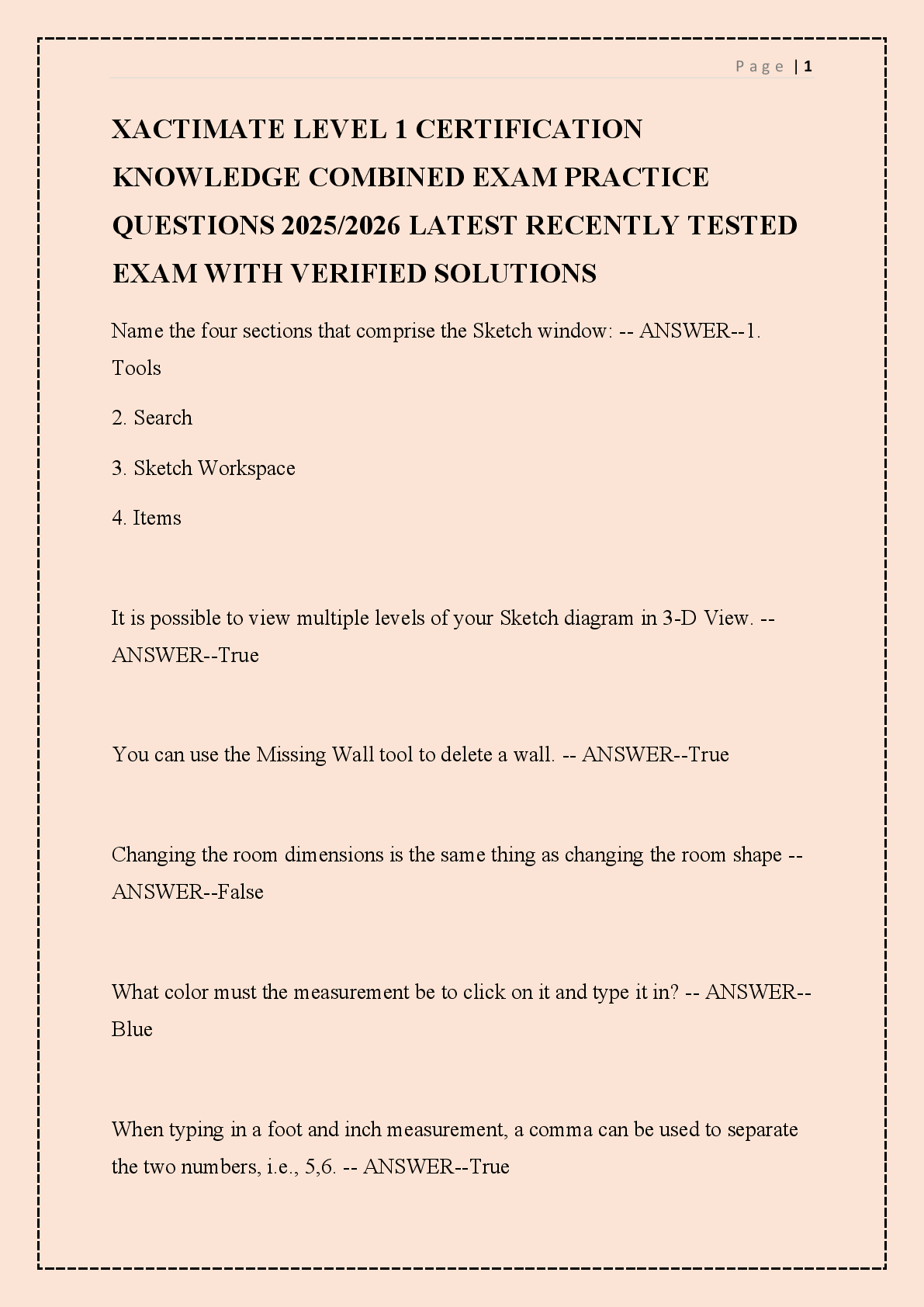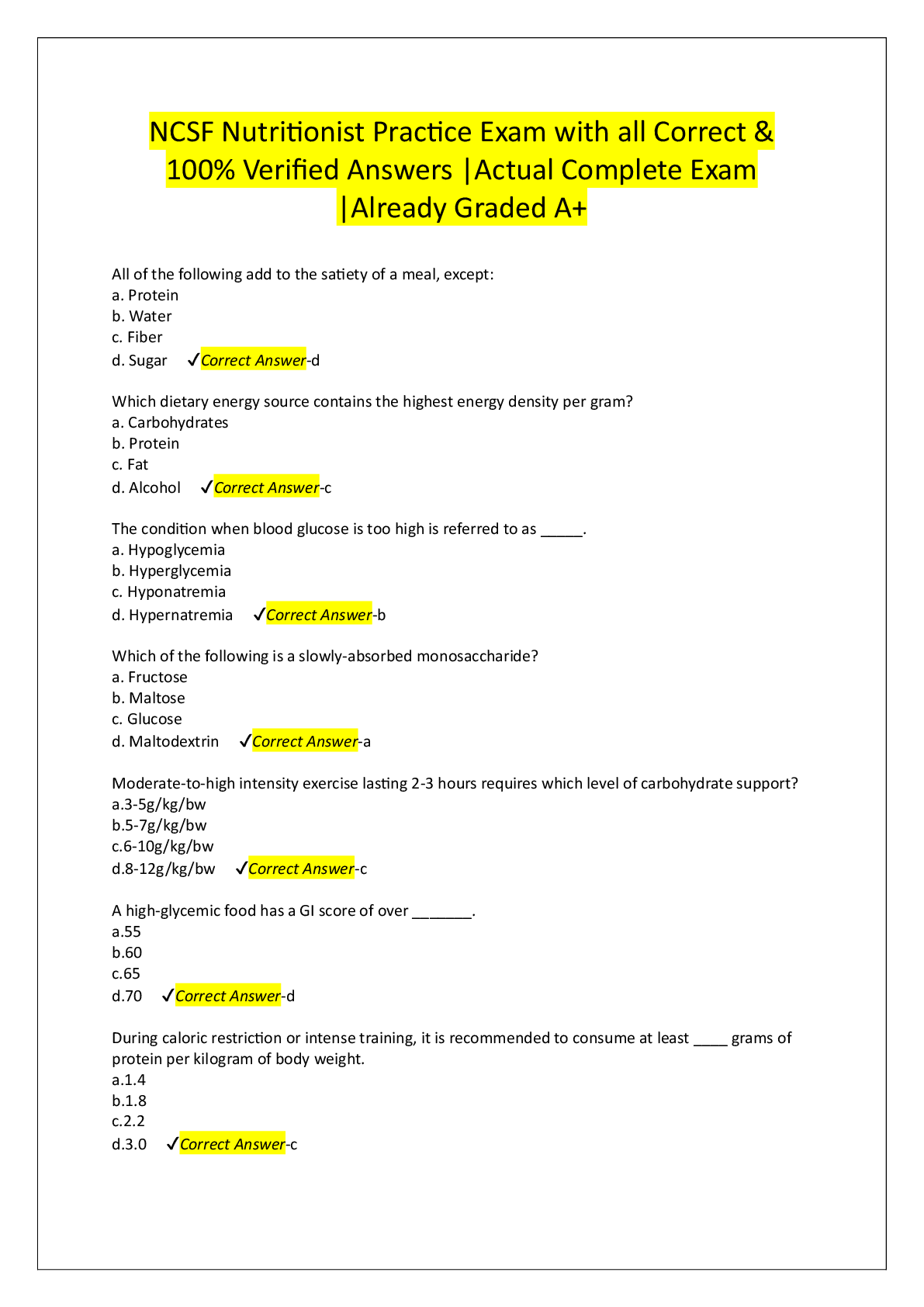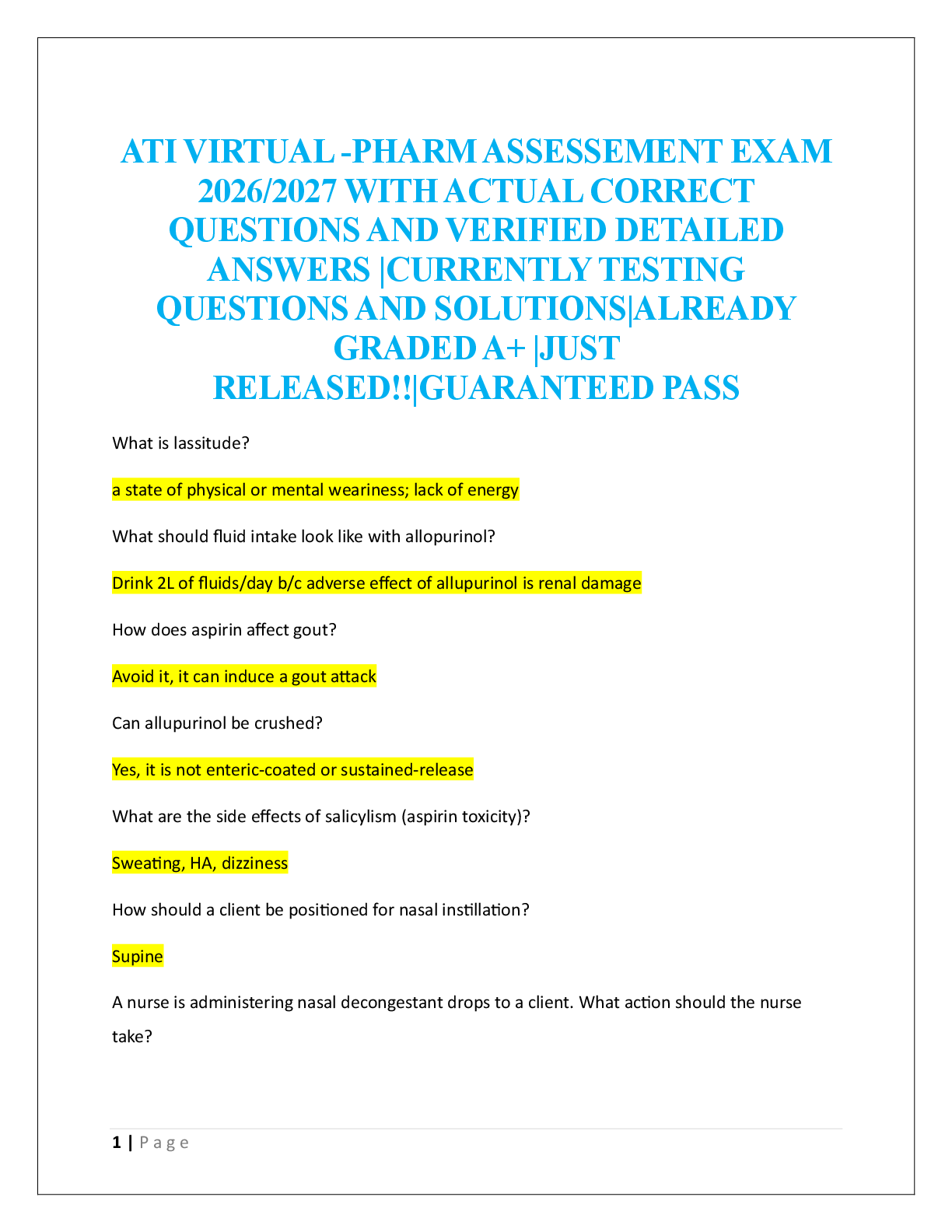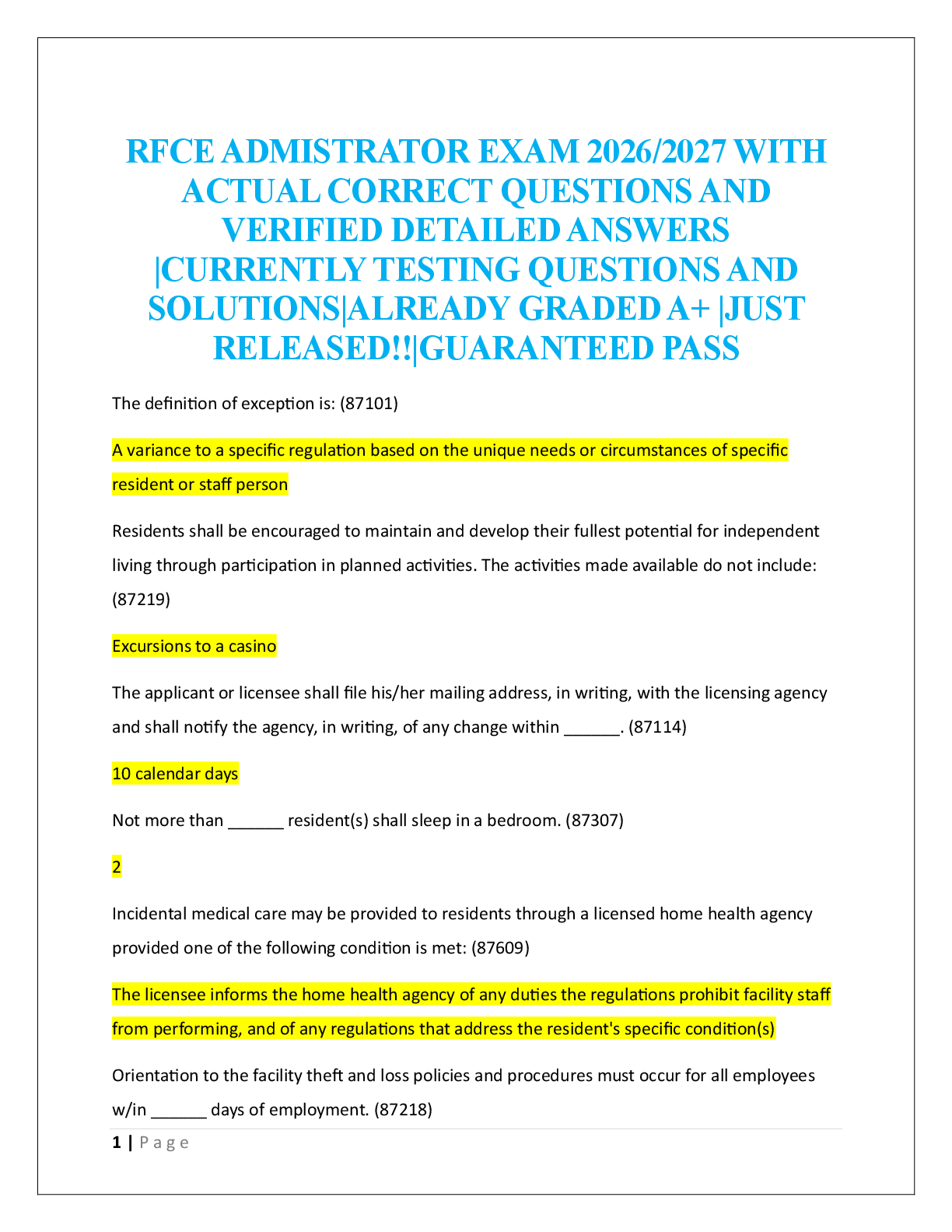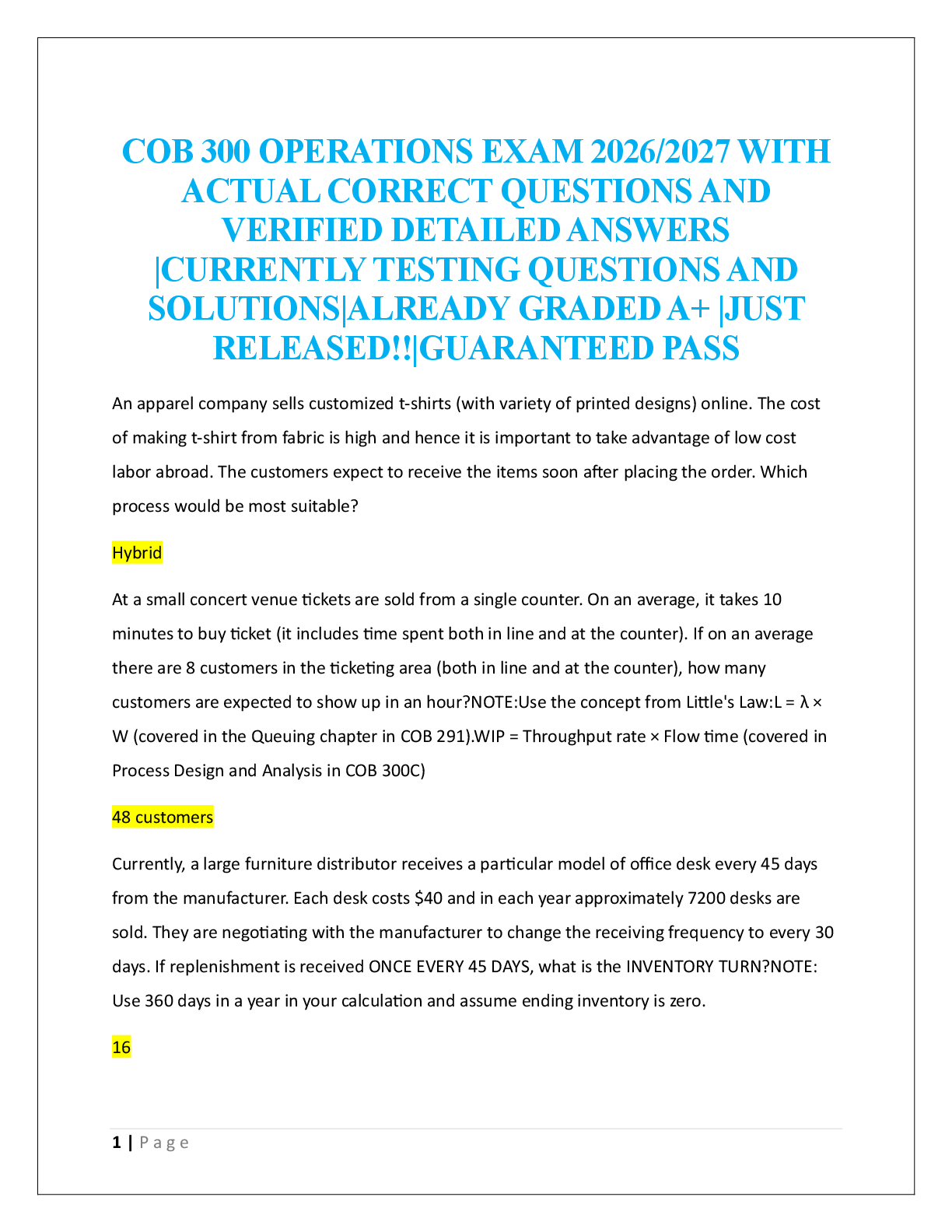Paramedic Trauma Quiz 6 & 7 with correct Answers
Document Content and Description Below
Which of the following best describes the effect of hyperventilation in the brain-injured patient? Select one: a. It is beneficial, because vasodilation results in increased cerebral blood flow. ... b. It is detrimental, because vasodilation causes an increase in tissue edema. c. It is beneficial, because vasoconstriction results in decreased tissue edema. d. It is detrimental, because vasoconstriction results in decreased cerebral perfusion. Feedback - ANSWER d. It is detrimental, because vasoconstriction results in decreased cerebral perfusion Your patient is a 45-year-old man with extensive blunt trauma to the face. He has decorticate posturing in response to pain; weak, irregular respiratory effort at 6 per minute; and a heart rate of 50 with a good radial pulse. The patient appears to have nasal and mandibular fractures, and an oropharyngeal airway is insufficient to keep the tongue from the posterior pharynx. Which of the following has the most potential to negatively impact the patient? Select one: a. Retrograde intubation b. Oral intubation under direct laryngoscopy c. Nasotracheal intubation d. A non-visualized dual-lumen airway - ANSWER c. nasotracheal intubation Which of the following medications may be indicated in the prehospital management of the patient with traumatic brain injury? Select one: a. Methylprednisolone b. Diazoxide c. Mannitol d. Furosemide - ANSWER c. mannitol Which of the following correctly describes the impact of motorcycle helmet use? Select one: a. Helmet usage is associated with a 10 percent reduction in serious head injuries. b. There have been no reported fatalities from motorcycle collisions in which the riders were wearing helmets. c. Helmet usage decreases the risk of serious head injuries but increases the risk of cervical-spine injuries. d. Helmet usage results in a more than 50 percent reduction in serious head injuries. - ANSWER d. Helmet usage results in a more than 50 percent reduction in serious head injuries. Which of the following parameters should be used to guide the oxygenation and ventilation of the patient with a traumatic brain injury? Select one: a. Maintain an oxygen saturation level of at least 96 percent and a capnography reading between 35 and 40 mmHg. b. Maintain an oxygen saturation level of at least 90 percent and a capnography level < 45 mmHg. c. Maintain an oxygen saturation level of at least 98 percent and a capnography reading > 45 mmHg. d. Maintain an oxygen saturation level of at least 90 percent and a capnography reading < 35 mmHg. - ANSWER a. Maintain an oxygen saturation level of at least 96 percent and a capnography reading between 35 and 40 mmHg. You are caring for a 22-year-old amateur boxer who complained of a sudden obstruction of part of his visual field. This complaint is most consistent with which of the following conditions? a. Extrusion of the eyeball b. Subconjunctival hemorrhage c. Hyphema d. Retinal detachment - ANSWER d. Retinal detachment Regarding the primary assessment of the patient with suspected traumatic brain injury, which of the following describes the best approach to assessing the patient's neurological functioning? a. The use of AVPU b. Assessing the patient for level of consciousness and orientation to person, place, and time c. Assessing a revised trauma score d. Assessing a Champion trauma scale score - ANSWER b. Assessing the patient for level of consciousness and orientation to person, place, and time Your patient has received blunt facial trauma due to an assault. For which of the following injuries should you maintain a high index of suspicion? a. Airway obstruction b. Hypoxia due to aspiration of blood c. Basilar skull fracture d. Lumbar spine trauma - ANSWER c. Basilar skull fracture The ________ is one of the thinnest and most frequently fractured cranial bones. a. temporal b. ethmoid c. parietal d. occipital - ANSWER a. temporal Which of the following patients fit the criteria for application of spinal precautions in the prehospital setting? a. An 85-year-old man who has fallen down three steps and has a large laceration to the occipital region of the skull, but no complaints of pain b. A 21-year-old man who was diving into a pool and states he hit his head, but is out of the pool and ambulatory upon your arrival with no complaint of neck or back pain c. A 36-year-old woman who was involved in a minor motor vehicle crash with an obvious closed tibia fracture d. None of these - ANSWER d. none of these During the early care for a patient with a basilar skull fracture in the prehospital setting, which of the following would be an unexpected finding? a. Periorbital ecchymoses or "raccoon eyes" b. CSF otorrhea c. Blood mixed with cerebral spinal fluid flowing from the mouth d. CSF rhinorrhea - ANSWER a. Periorbital ecchymoses or "raccoon eyes" Which of the following skull fractures is most common? a. Linear b. Basilar c. Depressed d. Comminuted - ANSWER a. Linear Your patient is a 7-year-old male pedestrian who was struck by a vehicle. Your assessment reveals bleeding from the right auditory canal. Which of the following describes the most appropriate way to manage this? Select one: a. Determining the presence or absence of cerebrospinal fluid is a low priority. Pack the auditory canal with sterile gauze to control bleeding. b. Use a "halo" test to determine whether cerebrospinal fluid is in the blood. If it is, loosely cover the ear with a sterile dressing to prevent contamination while allowing blood to flow freely from the ear. If cerebrospinal fluid is not present, pack the ear canal with sterile gauze to control bleeding. c. Determining the presence or absence of cerebrospinal fluid in the blood is a low priority. Loosely cover the ear with a sterile dressing to prevent contamination while allowing blood to flow freely from the ear. d. Check the glucose level in the blood draining from the ear. If it is less than the patient's blood glucose level, there is cerebrospinal fluid present. Cover the ear loosely with a sterile dressing to prevent contamination while allowing blood to flow freely from the ear. If the glucose level of the blood from the ear is the same as the patient's blood glucose level, pack the auditory canal with sterile gauze to control bleeding. - ANSWER c. Determining the presence or absence of cerebrospinal fluid in the blood is a low priority. Loosely cover the ear with a sterile dressing to prevent contamination while allowing blood to flow freely from the ear. When developing a spinal clearance policy, age: Select one: a. should never be considered, as age does not matter. b. should be considered only when the patient is a man between the ages of 21 and 35. c. should be considered, as the very old may not be able to describe their symptoms accurately. d. should be considered only if the patient is a minor. - ANSWER c. should be considered, as the very old may not be able to describe their symptoms accurately. Your patient is a 22-year-old female assault victim. She has blunt trauma to the face with swelling around the right eye and zygomatic area. Upon assessing her eye movement, you note that the right eye cannot follow your finger and does not move. Which of the following MOST likely explains this finding? Select one: a. She has a fracture of the orbit that has trapped the optic nerve, thereby paralyzing her gaze. b. She has direct trauma to the eyeball that has damaged the intrinsic muscles of the eye. c. She has a fracture of the orbit that has trapped the extrinsic eye muscles. d. She has direct trauma to the eyeball that has damaged the optic nerve, thereby paralyzing her gaze. Feedback - ANSWER c. She has a fracture of the orbit that has trapped the extrinsic eye muscles. For the head injury patient without signs of herniation, adjust ventilation rates to maintain a capnography reading of between: a. 15 and 20 mmHg. b. 25 and 30 mmHg. c. 45 and 50 mmHg. d. 35 and 40 mmHg - ANSWER d. 35 and 40 mmHg Your patient is a 37-year-old male unrestrained driver of a vehicle. You find him with his upper body across the console and his head hanging down into the passenger's side floorboard area. You note pooled blood from a scalp wound. After immobilizing him and loading him into the ambulance, where you have more light for your examination, you note that he has a large, full-thickness avulsion of the scalp. The patient's heart rate is 112, respirations are 20, and blood pressure is 82/50. Which of the following statements about this patient are TRUE? 1. The scalp wound itself cannot account for the patient's vital signs. 2. The scalp wound itself may account for the patient's vital signs. 3. The patient's vital signs are consistent with increasing intracranial pressure. 4. Nothing about the vital signs indicates increased intracranial pressure. Select one: a. 1 and 4 b. 2 and 3 c. 1 and 3 d. 2 and 4 - ANSWER d. 2 and 4 When palpating the spine of a patient during your assessment, you are feeling the: Select one: a. spinous processes. b. vertebral bodies. c. transverse vertebral processes. d. vertebral pedicles. - ANSWER a. spinous processes A patient who has dived into a shallow pool and hit his head on the bottom is MOST likely to have which of the following types of injuries? Select one: a. Cervical hyperextension b. Cervical hyperflexion c. Axial distraction d. Axial loading - ANSWER d. axial loading Recent research has provided evidence of which of the following regarding spinal injury assessment? Select one: a. Only trauma patients with signs and symptoms of neurological deficit need to receive spinal immobilization. b. Paramedics cannot reliably identify patients who are likely to have spinal injuries. c. All trauma patients should be assumed to have spinal injuries. d. There are reliable criteria for determining the likelihood of spinal injury. - ANSWER d. There are reliable criteria for determining the likelihood of spinal injury. Which of the following is a common mechanism of injury associated with spinal cord injuries? Select one: a. Falls greater than 20 feet b. Bungee jumping c. Shallow water diving d. All of these - ANSWER d. all of these Which of the following best describes the goals of manual cervical spine stabilization? Select one: a. Preventing movement of the head in any direction; prevent any flexion/extension, rotation, or lateral bending b. Keeping the head in an "eyes forward" position; applying enough traction to cause axial unloading, which is 18 to 22 pounds in the average adult c. Preventing rotation of the head; avoiding any upward lifting or downward pressure on the cervical spine d. Preventing movement of the head in any direction; applying gentle axial pressure to stabilize the vertebral column Feedback - ANSWER a. Preventing movement of the head in any direction; prevent any flexion/extension, rotation, or lateral bending Which of the following statements about the administration of dextrose to the patient with a traumatic brain injury is TRUE? Select one: a. Hypoglycemia is associated with a poorer neurologic outcome; if the blood glucose level is less than 60 mg/dL, administer 25 grams of dextrose. b. Hypoglycemia is inconsequential to neurologic outcome; assessing the blood glucose level is not a priority. c. Hyperglycemia is associated with a poorer neurologic outcome; never administer dextrose to a patient with traumatic brain injury. d. Hypoglycemia is associated with a poorer neurologic outcome. All patients with suspected traumatic brain injury who have an altered mental status should receive 25 grams of dextrose intravenously. - ANSWER a. Hypoglycemia is associated with a poorer neurologic outcome; if the blood glucose level is less than 60 mg/dL, administer 25 grams of dextrose. You are caring for a 20-year-old skateboarder who crashed into a brick retaining wall at the bottom of a steep hill. He has blunt trauma to his face with nose deformity, loose teeth, and bleeding from the nose and mouth. Although you have answered him several times, he keeps repeating to you, "What happened? It seems like I'm having a bad day." This is most indicative of which of the following? a. Aphasia b. Retrograde amnesia c. Decorticate disorientation d. Anterograde amnesia - ANSWER d. Anterograde amnesia Which of the following are the two most important prehospital considerations for head injury patients? Select one: a. Cervical spine immobilization and ventilation b. ICP monitoring and administering corticosteroids c. Ventilation and administering corticosteroids d. Ventilation and maintaining adequate blood pressure - ANSWER d. Ventilation and maintaining adequate blood pressure Your patient states that he had a traumatic brain injury from a motorcycle collision three years ago. You notice that his gait is unsteady and his movements are a bit jerky. You suspect that he has damage to which of the following structures? Select one: a. Falx cerebri b. Reticular activating system c. Third cranial nerve d. Cerebellum - ANSWER d. Cerebellum Which of the following is NOT a component of the Glasgow Coma Scale? Select one: a. Eye opening b. Motor ability c. Pupillary reaction d. Verbal response - ANSWER c. Pupillary reaction Which of the following is the largest element of the nervous system? Select one: a. Cerebellum b. Pons c. Medulla oblongata d. Cerebrum - ANSWER d. cerebrum Which of the following Glasgow Coma Scale scores indicates serious brain injury? Select one: a. < 3 b. Between 12 and 15 c. < 8 d. < 15 - ANSWER c. < 8 The cerebral perfusion pressure is represented by which of the following equations? Select one: a. CPP = MAP - CVP b. CPP = CVP - ICP c. CPP = MAP - ICP d. CPP = ICP - MAP - ANSWER c. CPP = MAP - ICP Which of the following mechanisms causes indirect brain injury? Select one: a. Coup/contrecoup injuries b. Systemic hypotension combined with increasing intracranial pressure c. Cushing's reflex d. Acceleration/deceleration forces without a direct blow to the cranium - ANSWER b. Systemic hypotension combined with increasing intracranial pressure Which of the following best describes consensual reactivity of the pupils? Select one: a. It is a pathological phenomenon. When a penlight is shone into one eye, both pupils constrict. b. It is a normal phenomenon. When a penlight is shone into one eye, only that pupil will constrict, while the other pupil is unaffected. c. It is a normal phenomenon. When a penlight is shone into one eye, both pupils constrict. d. It is a pathological phenomenon. When a penlight is shone into one eye, only that pupil constricts, while the other pupil is unaffected. - ANSWER c. It is a normal phenomenon. When a penlight is shone into one eye, both pupils constrict. Your patient is a 12-year-old boy who was struck in the right temporal area of the head with a baseball. He had a brief loss of consciousness and is alert on your arrival. You note that he is becoming drowsy and has a strong radial pulse of 60, a blood pressure of 140/70, and a respiratory rate of 12. Which of the following best describes this patient's condition? Select one: a. He is stable, and he most likely has a subarachnoid hemorrhage with no increase in intracranial pressure. b. He is critical, and he most likely has an epidural hematoma with rapidly increasing intracranial pressure. c. He is stable, and he most likely has a mild diffuse axonal injury with no increase in intracranial pressure. d. He is serious, and he most likely has a subdural hematoma with an increase in intracranial pressure. - ANSWER b. He is critical, and he most likely has an epidural hematoma with rapidly increasing intracranial pressure. The shearing, stretching, and tearing associated with rapid acceleration/deceleration forces acting on the brain result in which of the following types of brain injury? Select one: a. Direct, diffuse b. Indirect, diffuse c. Indirect, focal d. Direct, focal - ANSWER a. Direct, diffuse For the patient with suspected traumatic brain injury, the ideal positioning of the patient for transport is: Select one: a. in a left lateral recumbent position on the backboard. b. on a long backboard with the foot of the backboard in a 15-degree Trendelenburg position. c. on a long backboard with the patient's feet elevated on pillows to achieve a 15-degree angle. d. on a long backboard with the head of the backboard elevated 15 to 30 degrees. - ANSWER d. on a long backboard with the head of the backboard elevated 15 to 30 degrees. When CPP falls below the critical level of 50 mmHG, autoregulation does which of the following to maintain CPP and cerebral perfusion? Select one: a. Decreases blood pressure b. Increases blood pressure c. Decreases intracranial pressure d. Increases intracranial pressure - ANSWER b. Increases blood pressure Which of the following about the use of prehospital fluid resuscitation in the patient with a traumatic brain injury is TRUE? Select one: a. Administer fluids aggressively regardless of the patient's blood pressure. b. Do not administer fluids unless the patient's blood pressure drops below 60 mmHg, because the administration of fluids leads to increased cerebral edema. c. Administer fluids as needed to maintain a systolic blood pressure above 90 mmHg. d. The use of hypertonic fluids is indicated to maintain vascular volume while reducing tissue edema. - ANSWER c. Administer fluids as needed to maintain a systolic blood pressure above 90 mmHg. Which of the following best describes the role of rapid sequence intubation (RSI) in the prehospital management of patients with traumatic brain injury? Select one: a. It is beneficial and should be used for all patients with traumatic brain injury who are experiencing trismus or who have an intact gag reflex. b. It is supported by anecdotal evidence, but no studies have been done to determine its feasibility or usefulness. c. It is controversial because of conflicting study results. d. It is detrimental, resulting in poorer neurological outcomes than in patients who received standard airway management. - ANSWER c. It is controversial because of conflicting study results. Which of the following statements about the patient in neurogenic shock is NOT true? Select one: a. The patient's heart rate may be slow. b. The patient's blood pressure is decreasing. c. Signs of hypovolemic shock may be masked. d. Unopposed sympathetic nervous system stimulation results in generalized pallor and diaphoresis. - ANSWER d. Unopposed sympathetic nervous system stimulation results in generalized pallor and diaphoresis Coup injuries commonly occur in which region of the brain? Select one: a. Frontal region b. Occipital region c. Temporal region d. Neuronal region - ANSWER a. Frontal region Anterior cord syndrome is caused by which of the following mechanisms? Select one: a. Tearing of the anterior cord due to hyperextension mechanisms b. Disruption of arterial blood supply to the anterior cord c. Laceration of the anterior cord caused by bone fragments d. Contusion of the anterior cord caused by blunt trauma - ANSWER b. Disruption of arterial blood supply to the anterior cord The diaphragm is controlled by peripheral nerve roots ________ through ________. Select one: a. C-3; C-7 [Show More]
Last updated: 3 years ago
Preview 1 out of 32 pages
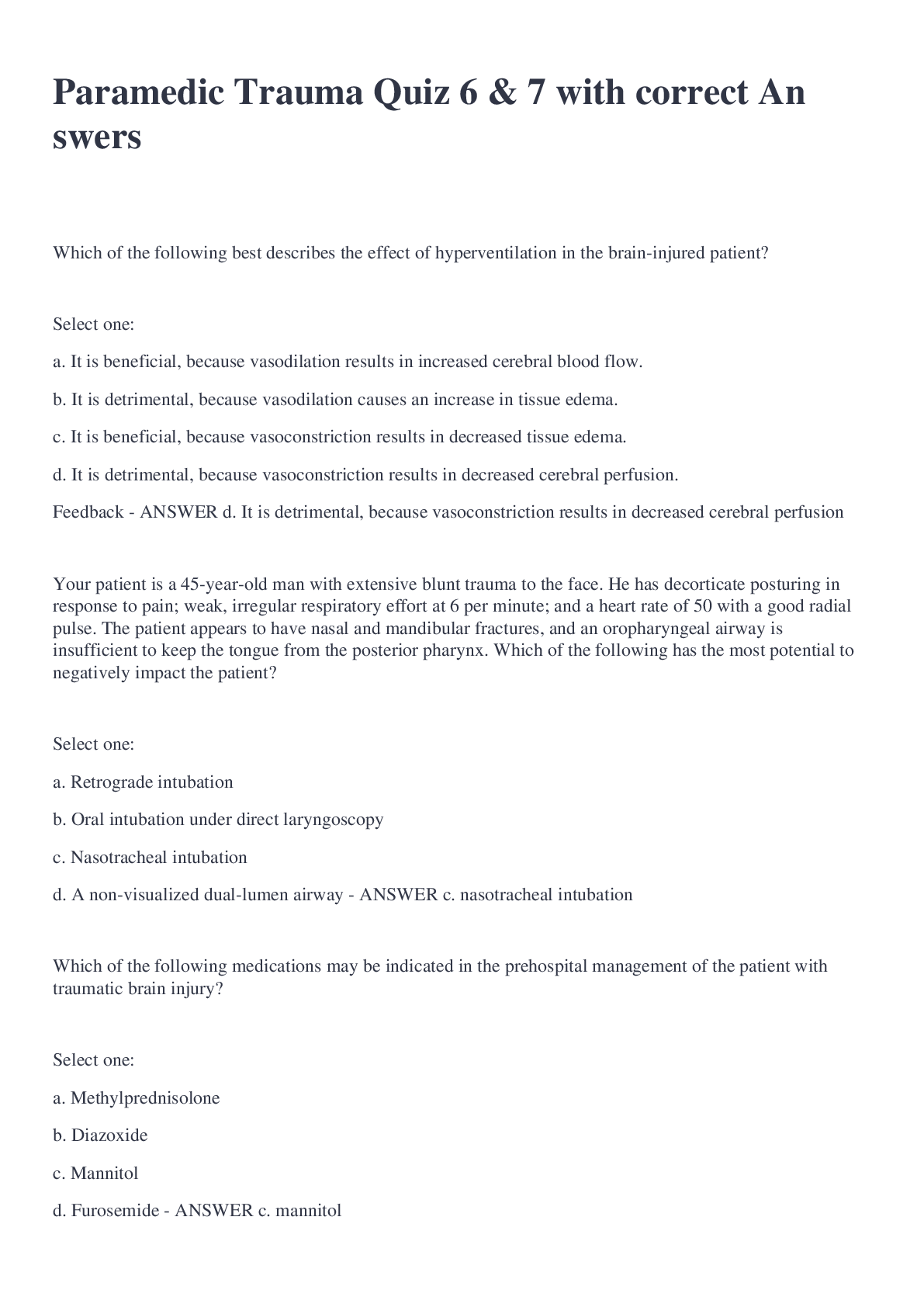
Buy this document to get the full access instantly
Instant Download Access after purchase
Buy NowInstant download
We Accept:

Reviews( 0 )
$8.00
Can't find what you want? Try our AI powered Search
Document information
Connected school, study & course
About the document
Uploaded On
Sep 02, 2022
Number of pages
32
Written in
All
Additional information
This document has been written for:
Uploaded
Sep 02, 2022
Downloads
0
Views
66



